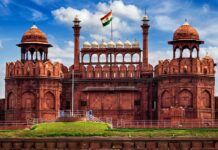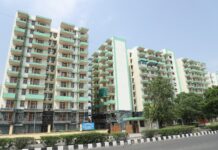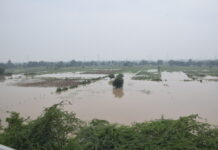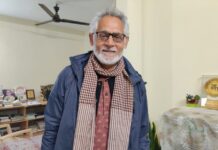[vc_row][vc_column][vc_column_text]
Banking on traditional methods of water conservation, he led his village to opulence and glory.
“Water cannot be secured for the next generation unless each village is turned into a “jalgram” (water village). It is the only solution to the water crisis the country is facing today,” proclaims Umashankar Pandey from a village Jakhni in Banda District UP.
Umashankar is speaking from his own experience. He successfully pioneered a water-conservation scheme to rid his village of perennial dry spells. The village, Jakhni, has become a model village for the conservation of water today. Thanks to his untiring efforts over the years, the government has declared the village jalgram.
The saga of success in the fight against scarcity of water has come into the limelight with the Jal Shakti Mantralay spreading the story of the village’s journey from the dry spell to opulence across the country. The mantralay called the district magistrates (DMs) to develop at least two jalgrams in every district on the lines of Jakhni.
“It’s a proud moment for us! Now that our village has been recognised by the Centre as a model village, we would like to see villages across the country replicate our model. If this happens, there will be thousands of jalgram in the country,” said Umashankar with a triumphant smile on his face.
The story of Jakhni is set in the mid-90s when Umashankar Pandey, as a youth, was determined to do something to resolve the persistent water crisis in his village. He said the level of underground water at that time was below 80 feet and hence the entire area was facing drought. As a consequence of the dry spell, unemployment and deprivation had become a fait accompli for the village. In desperation, the villagers were even taking to crime.


“It was a symbolic move to draw the attention of the people to the crisis and demonstrate how we could do our bit to get over it,” recalls Umashanker.
They arranged earthen pots to supply water to convey to accentuate the traditional way of water conservation. This symbolic gesture sent home the message and the people started thinking and talking about the issue. This way, the community became aware of the importance of water conservation.
Young Umashankar would never have imagined that an informal journey could become a milestone 25 years later. Soon, he adopted a formal approach to address the problem with the revival of the traditional resources of water in his village at the instance of her mother after an unfortunate incident.
Sharing his experience, he said, “Once a woman died in the village. Her body was kept for her son to return from Gujarat for the funeral. The entire village was anxiously waiting for the return of the youth to perform the last rites of his mother. This incident made me realise that there was a dearth of able-bodied men in the village. With most men gone away in search of livelihood, the village was left with only women, children, and elders.”
The incident left him in deep introspection. His mother told him to do something for the village so that people don’t have to leave their homes and hearth in search of a livelihood. She advised him to engage people in agriculture so that they do not have to leave the village for a living and no mother is left behind to wait for her last rite. It was a defining moment in my life when I decided to start a community campaign in my village.”
Soon, Umashankar Pandey started holding door-to-door meetings with like-minded people of the village over the issue of water. He would discuss with them ways to restore groundwater levels so that people could start farming. His focus was on the revival of water bodies like ponds and wells in the village.
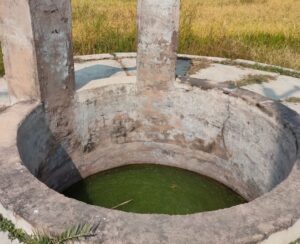

“Now, the water is at 8 to 10 feet underground from the surface. One can touch the water of the wells on the agricultural fields by hand. The soil has become so fertile that farmers can now reap a rich harvest of rice and wheat. The village, which once hardly possessed 10 bicycles 20 years ago, now boasts of 45 tractors. The extreme poverty has paved the way for opulence with every villager having a bank balance of at least Rs 25,000 surplus, all due to conservation of water.”
Umashankar says he had drawn the inspiration for a model village concept from Dr. APJ Abdul Kalam. “In 2005, I attended a workshop in Delhi where he had the privilege to see Dr. Kalam who explained the concept of water village to the audience. He said it is essential for the survival of the future generation. Inspired by the idea, I started working on the concept. I studied the traditional methods of water conservation propounded by ancient environment poet Ghagh and eminent water activist Anupam Mishra. We adopted a policy to save every drop of water at the source.”
Thus came the concept of med bandhi (water bank). In keeping with the technique, Umashankar and his associates ensured that not a single farmland is left without a med bandh. This measure immensely contributed to the rise in water level.
Apart from this, they made nullahs (passageway for water) around the village so that wastewater could seep into the ground for re-circulation. They also encouraged people to use wastewater for growing vegetables along the nullah. This way, not a single drop of water is wasted.
Umashankar credits med bandhi on the agricultural fields for the success of his village. The villagers started planting trees alongside these meds. The novel concept Jakhni has adopted is named “med-par-ped”. Umashankar call it a success mantra.
In due course of time, villages in the entire district started following the Jakhni’s example and producing quality rice, especially of basmati variety, in huge quantities.
“In 2015-16, water was supplied to Bundelkhand by train. Now, the area has sold 10 lakh quintal paddy to the government. This is a paradigm shift on the socio-economic and socio-cultural front for the entire Bundelkhand area,” he noted.
Over 25 years of a journey into water activism earned Umashankar lots of laurels. The recognition from the government came his way as a crowning glory which could cherish all his life. During the interview with this correspondent, he fondly mentions tweets and encomiums from the policymakers of the nation.
“Prime Minister Narendra Modi described our village as a model in his Mann Ki Baat programme. The Ministry of Jal Shakti and Water Resources has tweeted on our model. The district administration has cited our success on social media several times. The Ministry said that each district in India should have two such model water villages. In 2018, the then DM of Banda applied for the Jakhni model for 470 gram panchayats. In the last five years, Banda achieved a rise of the water table by 1.34 metre through med bandhi.
Receiving all these encouraging messages is a humbling experience for me and a motivation to do more for society,” he concludes with a grin. He has some ambitious plans for his area. He wants to establish an environment university and a research centre for traditional methods for the conservation of water, the water that has given him and his village a school, a college, and above all a life to cherish.
[/vc_column_text][/vc_column][/vc_row]
Disclaimer: We do undertake rigorous checks on content provided by contributors before publishing the same. If you come across some factual errors, kindly bring this into our notice and we shall review your objection and claim as per our policy and display correction credits and corrections on the article itself.
The opinion expressed in the article is of the writer. Writer is a freelance journalist/journalist based in Delhi

